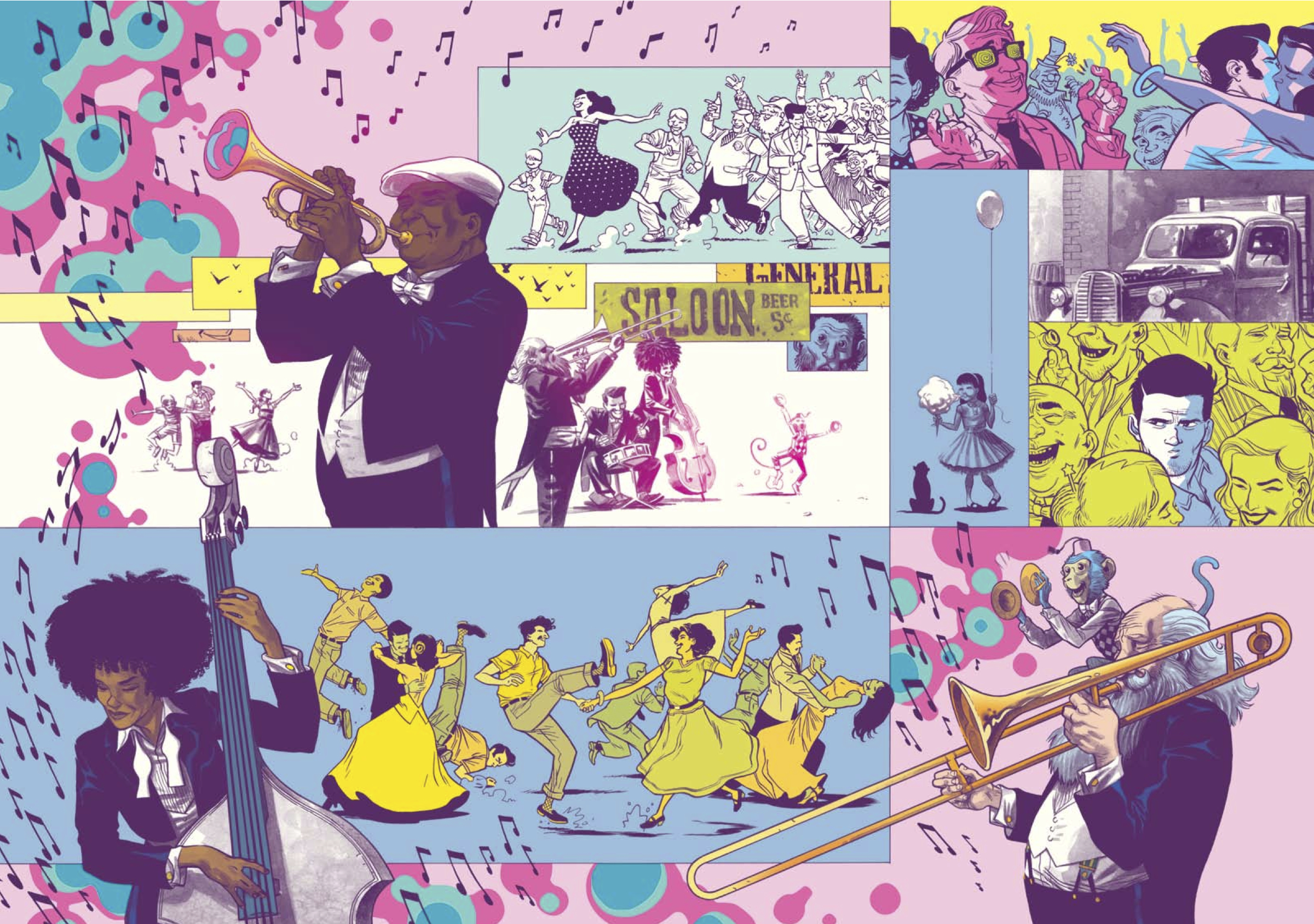 Jim Henson’s A Tale of Sand
Jim Henson’s A Tale of Sand
Writers: Jim Henson & Jerry Juhl
Artist: Ramon Perez
Publisher: Archaia Entertainment
Price: $29.95
This could all go very wrong.
A Jim Henson historian unearths a screenplay in Henson’s archives. It’s a full-length movie script that never saw the light of day. Sometimes there are reasons for that. Also, Henson is widely known for his puppetry work in films and television with the Muppets. This script has no Muppets in it, as the vision within was completely separate from the other work for which Henson became famous. There’s barely any dialog to the script, relying solely on the visuals and sound effects to carry the weight of the story. So on top of all of this, the Henson Company calls on Archaia Entertainment to bear the responsibility of revealing this film-that-never-happened to the world in graphic novel form. Jim Henson was such a visual artist…who could be counted on to develop his vision 20 years after his death?
This book seems impossible. Yet, if Henson taught anything to those of us who grew up learning to read and count from Sesame Street, to laugh from The Muppet Show, to love from Fraggle Rock, and to dream from The Dark Crystal and Labyrinth, it’s that anything is possible when Jim Henson is involved.
A Tale of Sand, written by Henson and longtime collaborator and friend Jerry Juhl, is probably unlike anything you would expect. It’s not like any of the work that Henson was best known. But Henson was no one-trick pony, and if his life hadn’t ended so unexpectedly, we would have seen more of what his brilliance could do. A Tale of Sand was written before Henson’s work on Sesame Street or The Muppet Show, and if you dip into what Henson did back in those days, you will come across a short film he directed called Time Piece (1965), which was actually nominated for an Academy Award for Best Short Film. Time Piece is a 9-minute montage of seemingly random shots which focus on an everyman, played by Henson himself, who is trapped by the frantic pace of time throughout life. It’s both funny and extremely poignant, and will remind you of the montage scenes from Sesame Street that Henson directed, as well. Once you watch that, A Tale of Sand fits right into the kinds of stories Henson told.
 The reader is thrust into the story, much like the main character Mac is. There is a confusion as to what is really going on, and Mac wanders through the book as our own personal avatar of discovery, wondering what will happen next. The plot is simple: Mac has to get from one point to another on a map, with an entire cast of friends and foes who are after him. Henson and Juhl make the adventure both exciting and existential, and also balance the self-discovery of Mac with gags and jokes that any Muppet fan would appreciate.
The reader is thrust into the story, much like the main character Mac is. There is a confusion as to what is really going on, and Mac wanders through the book as our own personal avatar of discovery, wondering what will happen next. The plot is simple: Mac has to get from one point to another on a map, with an entire cast of friends and foes who are after him. Henson and Juhl make the adventure both exciting and existential, and also balance the self-discovery of Mac with gags and jokes that any Muppet fan would appreciate.
If you have a keen eye, you will also notice that the deserts of the Southwest are the backdrop, which was also the setting of The Muppet Movie. In fact, there’s a used car lot in the desert that Mac stumbles upon that looks a lot like the one Kermit finds. Also, the getaway car that Mac gets is exactly the one that Fozzie drives. It’s touches like this that will please long-time Henson fans.
 If, however, you haven’t explored the world of Henson yet, you should read this because the book would not be possible without the work of the fantastic Ramon Perez. I mentioned earlier that Archaia had to find someone to bear the responsibility of bringing Henson and Juhl’s script to life. Perez does this exquisitely. Perez’s style is cartoony enough to draw you in to the surreal nature of the story, but realistic enough to distinguish this from a simple, childish story. For those who like the work of Jeff Smith, you’ll find Perez’s style just as smooth and clean, with a flair for dynamic action and movement through panels. Obviously, he is taking visual cues from Henson’s script, but it’s unclear how much he stands on that alone and how much he fills in the blanks. Either way, it works. In addition to the beautiful pencils and inks, Perez and colorist Ian Herring create a palate which is bright and vibrant, yet fits the surreal tone of the book. The palate reminds me of David Mazzuchelli’s Asterios Polyp, with blues, purples, and yellows used to shade and create mood.
If, however, you haven’t explored the world of Henson yet, you should read this because the book would not be possible without the work of the fantastic Ramon Perez. I mentioned earlier that Archaia had to find someone to bear the responsibility of bringing Henson and Juhl’s script to life. Perez does this exquisitely. Perez’s style is cartoony enough to draw you in to the surreal nature of the story, but realistic enough to distinguish this from a simple, childish story. For those who like the work of Jeff Smith, you’ll find Perez’s style just as smooth and clean, with a flair for dynamic action and movement through panels. Obviously, he is taking visual cues from Henson’s script, but it’s unclear how much he stands on that alone and how much he fills in the blanks. Either way, it works. In addition to the beautiful pencils and inks, Perez and colorist Ian Herring create a palate which is bright and vibrant, yet fits the surreal tone of the book. The palate reminds me of David Mazzuchelli’s Asterios Polyp, with blues, purples, and yellows used to shade and create mood.
The real difficulty in bringing this book to life is the visual storytelling aspect, since there is no audible soundtrack. Henson used sound effects frequently, and I imagine that if this had been a film, the sound would have been something to talk about. But Perez succeeds in visually representing the sound not just with onomatopoeia, but with sequential storytelling and action. You don’t have to see the word “kapow” or the jazz beats to hear the sound being created.
Upon reading A Tale of Sand, I almost couldn’t conceive of it being better if Henson had actually filmed it. This is one of the great things about the graphic novel medium. When done as well as this, it can not only enhance something meant for the screen, it can actually make it better.
Overall, it’s good to know that Henson and Juhl had some things tucked away, and that 20 years after Henson’s death and 44 years after he wrote the first script of A Tale of Sand, we are still treated to the genius this man was. I would wait another 20 or 44 years for someone like Ramon Perez to come along and realize completely the vision Henson and Juhl crafted.
It could have gone very wrong, but it certainly did not. Well done, Henson, Juhl, and Perez.
Jeff Jackson
jeff@comicattack.net
Check out Andy Liegl’s exclusive interview with Ramon Perez back in June here.


